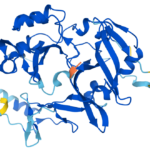A new “all-hazards” approach for reducing multiple catastrophic threats
By Rumtin Sepasspour | November 24, 2023
 D. Dibenski, Public domain, via Wikimedia Commons
D. Dibenski, Public domain, via Wikimedia Commons
Each of the various pathways to global catastrophe presents its own winding course of possibilities. Nuclear weapons, climate change, pandemics, advanced technologies, and space weather might appear as fundamentally different threats. However, they are not disconnected. They branch out from common drivers like geopolitical competition, economic growth, and technological advancement. The terrains for tackling the various threats are also similar, presenting shared challenges and features.
These routes don’t end in vastly different destinations either. Global catastrophes ultimately harm the same societal functions, among them critical infrastructure, health systems, food supply, and governance continuity.
An effective and efficient method for reducing catastrophic risk would use an “all-hazards” approach, tackling the risk holistically by capitalizing on characteristics or conditions shared among the threats. This can be achieved by managing threats as a whole and finding common themes between them. A two-pronged approach, the tactic will save energy and resources by fighting multiple threats at once, giving humanity a better chance at reducing overall global catastrophic risk.
Catastrophic risk in its entirety. Not uncommon in emergency management, an all-hazards approach recognizes that various sources of risk are not siloed. But as a research topic or policy matter, global catastrophic risk is typically seen through a threat-specific lens.
The main, and most obvious, benefit of an all-hazards approach is that it can treat multiple catastrophic scenarios at the same time. For example, alleviating tensions and competition between countries could reduce risk from nuclear, chemical, and biological weapons, as well as from artificial intelligence and other dual-use technologies.
A more subtle but equally important benefit of an all-hazard approach: It provides a failsafe for unknown or underestimated risk. Nuclear weapons, pandemics, and artificial intelligence risk receive a lion’s share of effort from global catastrophic risk research and advocates. These existential threats are assessed as more likely or impactful than others. But what if the assessment–including potential pathways or time frames–is wrong? And what if humans haven’t yet created or discovered the threat that wipes them out? Preventing and preparing for all catastrophes collectively circumvents human misjudgments and uncertainties.
Overarching policy manages risk as a whole. In practice, an all-hazard approach to global catastrophic risk policy can be achieved via two angles. The first takes a risk-management point of view. This approach involves several steps: governance, understanding, prevention, preparedness, response, communication, and collaboration. Each of these steps overarches not just one but a whole range of threats.
Let’s take risk governance, for instance. These structures, decision-making processes, and policy guidance would direct and coordinate government action on global catastrophic risk. For example, risk experts and the House of Lords of the United Kingdom have proposed a national “chief risk officer” to oversee government efforts for extreme risk.
National risk assessments in many countries already receive the all-hazards treatment. And the United States is delivering a holistic assessment of existential and global catastrophic risk under the Global Catastrophic Risk Management Act of 2022. Further government action could look to study, analyze, assess, monitor, and warn about this level of risk.
Preparing for global catastrophe can capitalize on an all-hazards approach. Here, policymakers can focus on the systems that make humans weak or vulnerable. Food security in a catastrophe has received significant attention from some researchers. However, building resilience in political, societal, infrastructure, and health systems will also be critical to survival across multiple catastrophic scenarios.
Governments will also need to consider how they collaborate and communicate with stakeholders. Engaging with citizens, the private sector, civil society, and other countries is critical to reducing collective risk. For example, proactive yet careful communications—like the Swedish Government’s If Crisis or War Comes pamphlet—can alert citizens to extreme risk and spur action.
Finding common themes. The second angle for an all-hazards approach is thematic. These themes, or policy areas, are those that cut across multiple threats and hazards. Addressing how these policy areas intersect with global catastrophic risk would be a powerful strategy.
There are nine primary cross-cutting areas: international relations and foreign policy; politics and governance; security and defense; economics and finance; natural resources and the environment; infrastructure and the built environment; health and healthcare; knowledge and information; technology and innovation; and society and culture.
Risk is driven by these different areas. For example, security or economic factors can lead to the risk that emerges from artificial intelligence, climate change, and weapons of mass destruction. The push for advances in knowledge, technology, and innovation drive risk from dual-use technologies, while stoking the vulnerabilities of societies and governance.
Reducing how these factors drive or exacerbate risk could be critical to preventing a threat from arising in the first place.
The intersections just described also work in the other direction: These policy areas are affected by global catastrophic risk. National security and economic development are severely hampered by global crises. Critical infrastructure, such as energy grids and telecommunications networks, could face catastrophic collapse. And the normal operations of government would be disrupted.
In this case, building preparedness and resilience would reduce the impact of a global catastrophe. The challenge, and opportunity, with cross-cutting policy is how one area weaves its way through the risk.
Food, for example, is relevant across many threats. As a risk driver, food contributes to climate change via greenhouse gas emissions, biodiversity loss through land clearing, and naturally occurring pandemics via zoonosis. Food systems are also vulnerable to global catastrophes. Extreme climate change and abrupt sun-blocking scenarios, such as nuclear winter and impacts from near-Earth objects and volcanic super-eruptions, could greatly and suddenly reduce global food supplies.
Taking the fight on, together. There’s plenty of work needed to make an all-hazards policy a global reality. The first steps involve identifying the common drivers behind multiple threats and agreeing to the critical systems that are vulnerable to catastrophic risk.
To bring experts from each of the threats together so they map the shared landscape of risk will require resources, forums appropriate to such efforts, and mechanisms for creating concrete plans. And advocacy groups must translate this holistic understanding of global risks into practical options for governments to consider.
Tackling each of the threats on their own can feel daunting, so considering all of them together might seem an insurmountable challenge. However, the power of an all-hazards approach is that it re-conceptualizes a variety of daunting problems into a shared—and vincible—opponent. It would not be fighting different battles but fighting the same battle on multiple lines.
By embracing an all-hazards approach, researchers, advocates, and policymakers from each of the threat domains can discover what binds them together and tackle their shared challenges. Instead of lone warriors facing their respective Goliaths, they can join forces and beat all their foes with a single stone.
Together, we make the world safer.
The Bulletin elevates expert voices above the noise. But as an independent nonprofit organization, our operations depend on the support of readers like you. Help us continue to deliver quality journalism that holds leaders accountable. Your support of our work at any level is important. In return, we promise our coverage will be understandable, influential, vigilant, solution-oriented, and fair-minded. Together we can make a difference.
Keywords: AI, catastrophes, climate change, nuclear threat, risk assessment, threat
Topics: Disruptive Technologies















